 |
|---|
THANK YOU!
YOUR PURCHASE OF THESE BOOKS SUPPORTS THE WEB SITES THAT BRING TO YOU THE HISTORY BEHIND OLD AIRFIELD REGISTERS
Your copy of the Davis-Monthan Airfield Register with all the pilots' signatures and helpful cross-references to pilots and their aircraft is available at the link. 375 pages with black & white photographs and extensive tables
---o0o---
The Congress of Ghosts (available as eBook) is an anniversary celebration for 2010. It is an historical biography, that celebrates the 5th year online of www.dmairfield.org and the 10th year of effort on the project dedicated to analyze and exhibit the history embodied in the Register of the Davis-Monthan Airfield, Tucson, AZ. This book includes over thirty people, aircraft and events that swirled through Tucson between 1925 and 1936. It includes across 277 pages previously unpublished photographs and texts, and facsimiles of personal letters, diaries and military orders. Order your copy at the link.
---o0o---
Military Aircraft of the Davis Monthan Register, 1925-1936 is available at the link. This book describes and illustrates with black & white photographs the majority of military aircraft that landed at the Davis-Monthan Airfield between 1925 and 1936. The book includes biographies of some of the pilots who flew the aircraft to Tucson as well as extensive listings of all the pilots and airplanes. Use this FORM to order a copy signed by the author, while supplies last.
---o0o---
Art Goebel's Own Story by Art Goebel (edited by G.W. Hyatt) is written in language that expands for us his life as a Golden Age aviation entrepreneur, who used his aviation exploits to build a business around his passion. Available as a free download at the link.
---o0o---
Winners' Viewpoints: The Great 1927 Trans-Pacific Dole Race (available as eBook) is available at the link. This book describes and illustrates with black & white photographs the majority of military aircraft that landed at the Davis-Monthan Airfield between 1925 and 1936. The book includes biographies of some of the pilots who flew the aircraft to Tucson as well as extensive listings of all the pilots and airplanes. Use this FORM to order a copy signed by the author, while supplies last.
---o0o---
Clover Field: The first Century of Aviation in the Golden State (available in paperback) With the 100th anniversary in 2017 of the use of Clover Field as a place to land aircraft in Santa Monica, this book celebrates that use by exploring some of the people and aircraft that made the airport great. 281 pages, black & white photographs.
---o0o---
Thanks to J.R . Hofmann for supplying us with the FAA records for NC337 and N7956P.
YOU CAN HELP
I'm looking for information and photographs of pilot Ohye and his airplanes to include on this page. If you have some you'd like to share, please click this FORM to contact me.
---o0o---
Thanks to pilot Ohye's nephew, George Ohye, for sharing family photographs and information.
---o0o---
HENRY SHIGEJI OHYE
"I believe that ability is not measured by race, creed and color but on efforts and hard works."
H. Ohye, 1964
First let me say that this was a conflictive page to write. At once, writing it galled my egalitarian sense that a man of Ohye's talents, intentions and desires was limited in his potential by his fellow American citizens, and by his government. But it cheered my understanding of “pioneer cussedness” to learn that he endured and succeeded, regardless. Henry Ohye's pilot biography is the first page I placed online with cloverfield.org on June 13, 2013.
Henry Ohye was born in California January 18, 1910, barely seven years after the Wright brothers' first flight. He passed away May 12, 1987, barely eighteen years after humans first walked on the moon. He is important for us to know, not only because his life spanned such vigorous aeronautical evolution, but also beause he was the first American born of Japanese parents to earn his Air Transport Rating, and he is a case study in perseverance.
He landed at least twice and signed the Register at Santa Monica. On his first visit he arrived from American Airport on August 20, 1931 (I'm looking for information about American Airport; can you HELP?). He was solo in the Timm C-165 Collegiate, NC337. The airplane, S/N 101, belonged to one “Captain Kelso.” Please direct your browser to the airplane's link for further information about its interesting life, and to discover that NC337 is still registered today with the FAA.
At the time of this landing, Ohye held private pilot certificate P19137. He also carried a fresh license from the National Aeronautic Association of the United States (NAA #7984)), pictured below, dated July 14, 1931.
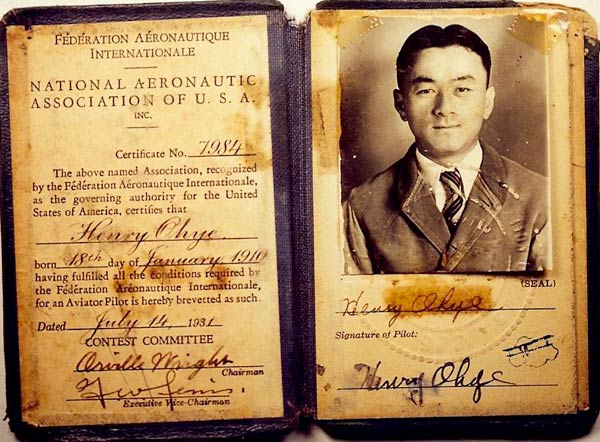 |
|---|
As was usual during the period, Ohye's NAA license was signed personally by Orville Wright.
He recorded his second landing in the Register on March 20, 1934. He arrived solo from Los Angeles, Mines Field at 1:45PM. He flew a Fleet with a Kinner K-5 engine. If you open Register page 26 in a separate window, you'll see that the airplane registration is difficult to read, but it looks like NC247H. The airplane belonged to “Hatatory” (see below).
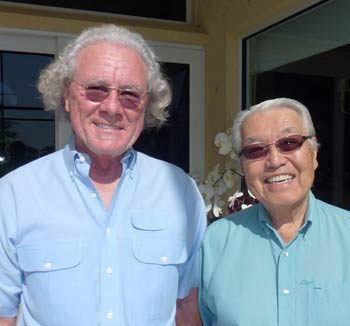 |
|---|
The Ohye family has shared Henry Ohye's artifacts and memorabilia for exhibit, including his NAA license, above. Incidentally, an exhilarating coincidence is that Henry's nephew, George Ohye, left, cited in the right sidebar, lives only four houses away from your Webmaster!
Henry Ohye's other nephew, Ken Grant, loaned Henry's flight logs to the Japanese American National Museum, Los Angeles. These were reacquired by George during September 2017.
Significantly, among the items are two pilot log books. The good news is that the logs we have are from the period of his landings at Clover Field. Both his Clover Field landings, and many more, were recorded in these logs. Download them at the links below.
For example, below is the left-hand half of page 7 from his first log book that documented his first landing on August 20, 1931. By August 20th he had accumulated about 60 hours of flight time over about 300 flights covering 5,500 miles. That works out to about 20 miles per flight at an average speed of 75 MPH. These approximate figures are about right for the kind of flying he was doing in the types of hardware he flew at the time.
 |
|---|
 |
Ohye's second log, pictured at right, provided a record of his pilot certifications. He earned his Private certification on March 5, 1931; his Limited Commercial certification on April 11, 1932, and his Transport certification on January 27, 1933. Thus, when we first met him at Clover Field in 1931, he had been a certificated pilot for only five months.
Essentially his first and second logs cover the same period and the same flights. The difference is that the log pictured at right is organized by type of airplane flown (see below).
His first landing at Clover Field was in the Timm NC337. From the log book page for his Timm flights, page 34 in the PDF, exhibited below, he flew that airplane from July 19, 1931 to January 27, 1932. This page records the total of his flights with the Timm brand, all in the same airplane. Most of his flights were round-robins back to American Airport. They were mostly logged as "cross-country" flights with landing practice.
His landing at Clover Field was logged about a quarter of the way down this page. As he wrote in the Clover Field Register, he arrived at Santa Monica from American Airport and returned there. His total flight time was 30 minutes that day. His total flight time in the Timm was 24 hours and 38 minutes, as shown at the bottom right of the page. .
Note the alphabetical tabs at the upper left and lower right of this page. His flights were arranged alphabetically by airplane type Similar tabs, "D" for Davis, "C" for California Cub, "B" for Bird, "F" for Fairchild, etc. were part of this book. Some tabs were torn off.
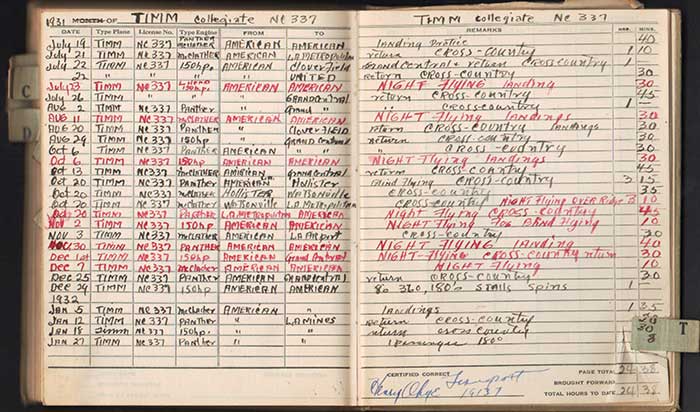 |
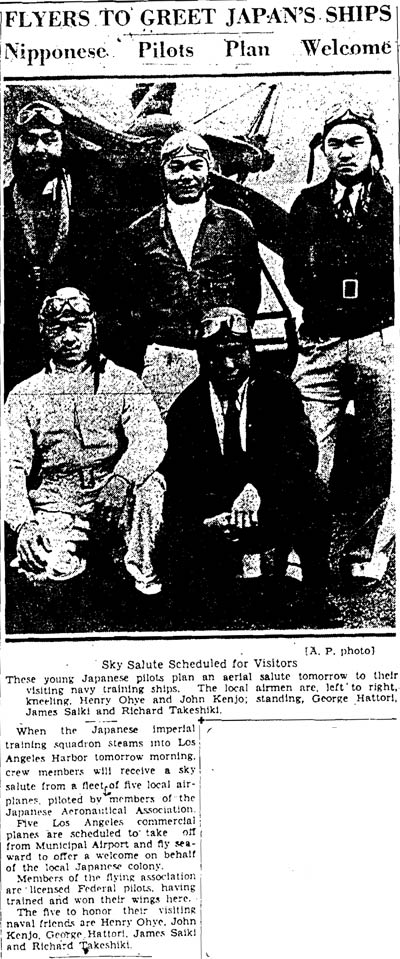 |
|---|
According to family history, Henry Ohye saw his first airplane at age 14 (1924) in Watsonville, CA where his parents tenant farmed. Also, according to a brief interview recorded between Mr. Ohye and John Underwood, his first airplane ride was at age 17 during the summer of 1927. Zensaku Azuma (1893-1967) was at the controls of Azuma's Hisso-powered Curtiss JN-4 ("Jenny;" registration number unknown). The ride lasted 15 minutes before engine problems cut it short.
Undeterred, by saving his money and overcoming wide-spread anti-Japanese prejudice of that era, Ohye began flying lessons in 1929. Lessons cost him $20 per hour. He soloed in 1931 and earned his private pilot license as well as his NAA certificate, above.
Although Henry Ohye had earned his commercial Transport license and had aspirations of being an airline pilot, no one would hire someone of Japanese heritage in the 1930s. Pilot Ohye understates in an article from the AOPA Pilot magazine you may download, below: "The turndowns were cold. No one asked about my experience or training. I could not help but believe it was because of a possible racial handicap."
This was also the case when, at the outbreak of the WWII, Henry tried to enlist in the U.S. Army Air Force. He was instead sent to Santa Anita Race Track to be interned along with thousands of other Japanese American citizens. He was subsequently shipped to the Gila River Internment Camp in Arizona where he spent the duration of the war (along with nephew, George, cited in the right sidebar; pictured above).
One newsworthy event involving Ohye was captured in the Los Angeles Times of April 18, 1933, right. Ohye is at lower left. A visit to Los Angeles harbor by ships of the Japanese Navy was fêted by Ohye and four other Japanese American fliers.
At the time, there were five Nisei pilots in California. Ohye had organized them into his pioneer Japanese Aeronautical Association (JAA). As a group (ALL the members of JAA are pictured at right), they departed from Clover Field for an aerial salute to the ships. There is a hiatus in the Clover Field Register for the days surrounding this date, therefore there is no record of the departure or return of the five pilots and their aircraft to Santa Monica. The same photograph, exhibited more clearly, is on page 2 of the downloadable brochure cited below.
Notice that one of the pilots is named George Hattori. Is he the owner of the Fleet airplane, NC247H, that Ohye flew to Clover Field on March 20, 1934, above, identified as belonging to “Hatatory?" Please Contact Your Webmaster if you know.
Another finding in Mr. Underwood's interview was that, in 1951, Henry Ohye taught then Japanese Vice Consul Moriki Tani to fly. This was prohibitied by the U.S. government at the time (being only 6 years post-WWII). Neither Ohye nor Tani were aware of this law, and Tani was not allowed to fly thereafter. Tani subsequently became ambassador to Portugal and was, in 1964, in the Imperial Treasury Department. According to this government Web source, as of January 22, 1975, Tani was the Japanese Ambassador to the German Democratic Republic.
In 1951 Ohye also appeared in the Los Angeles Examiner, ca. December, in two photographs, below, called to my attention by a site visitor. The link directs you to the University of Southern California Digital Library (USC). The captions provide the context of the photos, "Navy Ensign Harvey N. Kitaoka spins prop on private plane of Henry Ohye (in cabin) as they prepare for pleasure flight." Both photographs are dated December 27, 1951.
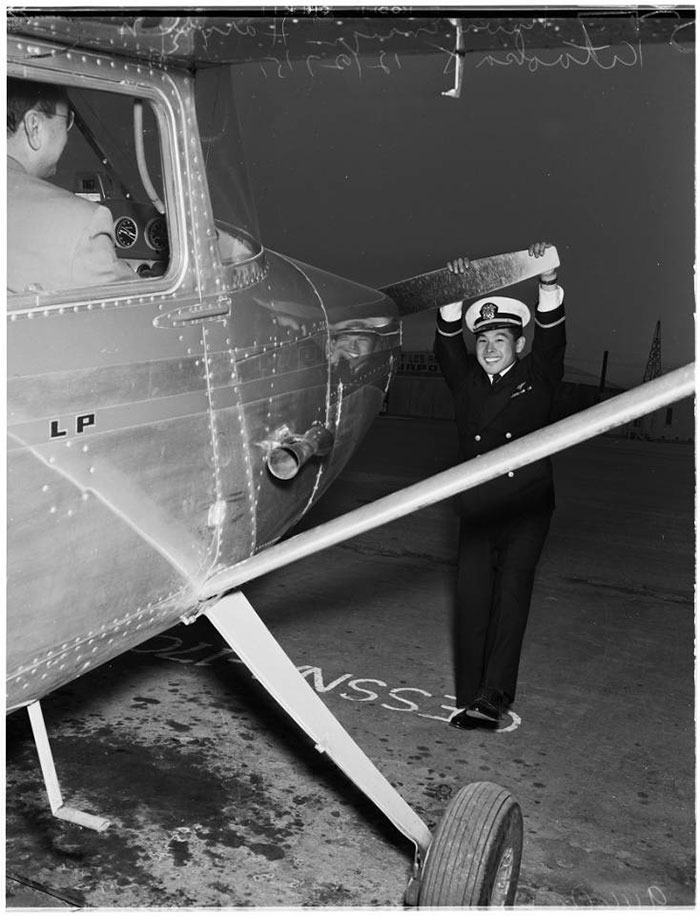 |
Ohye's nephew, George, recalls, "Henry had his Cessna 140 ... tied down at a local LA area airport. We flew to San Diego.... I remember shortly after taking off to return to LA, a Convair B-36 flew over us making such a racket and shaking the plane so hard that I thought we were in trouble. Henry said not to worry that the vibration was caused by the sound of the engines, not wake. That was in 1954 or 55." Kitaoka is cited in the AOPA article linked just below. A nephew published Kitaoka's eulogy at the link.
To note, the airplane in these photographs is a Cessna model 170, because it has four seats (look behind Kitaoka's seat, below). It is probably not Ohye's airplane, which was a model 140, which has two seats. See also the lettering on the hangar floor, above.
.jpg) |
Henry Ohye, however, is best known for his successful 1964 trans-Pacific, Oakland, CA to Tokyo, solo goodwill flight. He had dreamed of such a flight as a teen, and the fact that Zensaku Azuma, the pilot of his first airplane ride, had flown to Japan in 1930 strengthened his resolve.
Please direct your browser to this link to learn more about Azuma's flight to Japan in Davis-Monthan Register Travel Air NC4835. His flight was via "the long way," in that he flew from Los Angeles to New York, then shipped his airplane by boat to Europe, then flew to Japan via Paris, Berlin, Moscow, Siberia, Northern China and Korea.
On Ohye's trans-Pacific flight, however, his route of flight was Los Angeles-Oakland-Honolulu-Midway-Wake-Guam-Okinawa-Tokyo. He brought greetings from cities in California to their sister cities in Japan. Moriki Tani (see above) helped him deliver the official greetings. He made use of the navigation tools of the time, mostly dead reckoning and long-range navigation and communication radios.
His aircraft was a 1961 Piper Comanche, N7956P, that was modified with extra fuel tanks. The official FAA record for the airplane documents the installations of the special radios as well as the long-range fuel tanks. He was aided in these modifications and preparations by Max Conrad who signed the Davis-Monthan Register, and Art Goebel, who signed the Clover Field as well as the Davis-Monthan Register. Conrad and Goebel were pilots experienced and celebrated for their long-range flights. Goebel won the trans-Pacific Dole Race in 1927 and Conrad flew many trans-ocean flights on behalf of the Piper Aircraft Company. Below is a photograph of Ohye's airplane in Japan with Mt. Fuji in the background.
An article from the February, 1964 issue of AOPA Pilot is a the link ("The Nisei Birdman," 470kB PDF) which describes Ohye's intended flight, the preparations therefor, and other trophy flights he organized and flew. A quote from the article is instructive: "...Henry Ohye, now in his fifties, was the first American born of Japanese parents to earn his air transport rating [recall, in 1932] -- and the first to learn he would not be allowed to use it."
 |
|---|
Regardless, for the trans-Pacific flight, he named the plane Toku-Hana in honor of his parents, Tokutero Ohye and Hana Harome. You can see the radio antennas running from the top of the fuselage to the top of the empennage, and along the bottom of the aft fuselage. When he landed in Japan on July 7, 1964, it was a record crossing for a light aircraft on the Oakland to Honolulu and west route: 13 hours and 50 minutes. It might still stand. Does anyone KNOW?
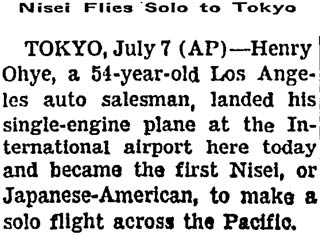 |
|---|
The FAA record also shows the airplane was registered to the Bank of Tokyo, and a permit was executed for its export from the U.S. to Japan. After a brief time, N7956P returned to the U.S. and went through several owners, including Max Conrad. Interestingly, when the airplane was returned to the U.S. it was registered on April 26, 1965 to none other than fellow Clover Field Register pilot Ross Hadley, who owned it for a little over two years.
Ohye's success on the flight was reported in The New York Times, left. The brevity of the article does not reflect the magnitude of his feat.
Another Times article from September 25, 1950, below, describes one of the trophy races sponsored by Ohye during the 1950s. This race ran from Los Angeles to Chicago, IL. The article states the event was populated only by four Japanese Americans (but see below), but later events included Caucasian Americans.
 |
|---|
Another article from a popular Nisei newspaper, Northwest Times from September 13, 1950, is below. Note this article states that nine Nisei were enrolled to compete.
 |
Ten days later, below, the Northwest Times reported five Nisei pilots were cited as competitors. Note the similarity of the graphic to that of the label exhibited just below (itineraries are different).
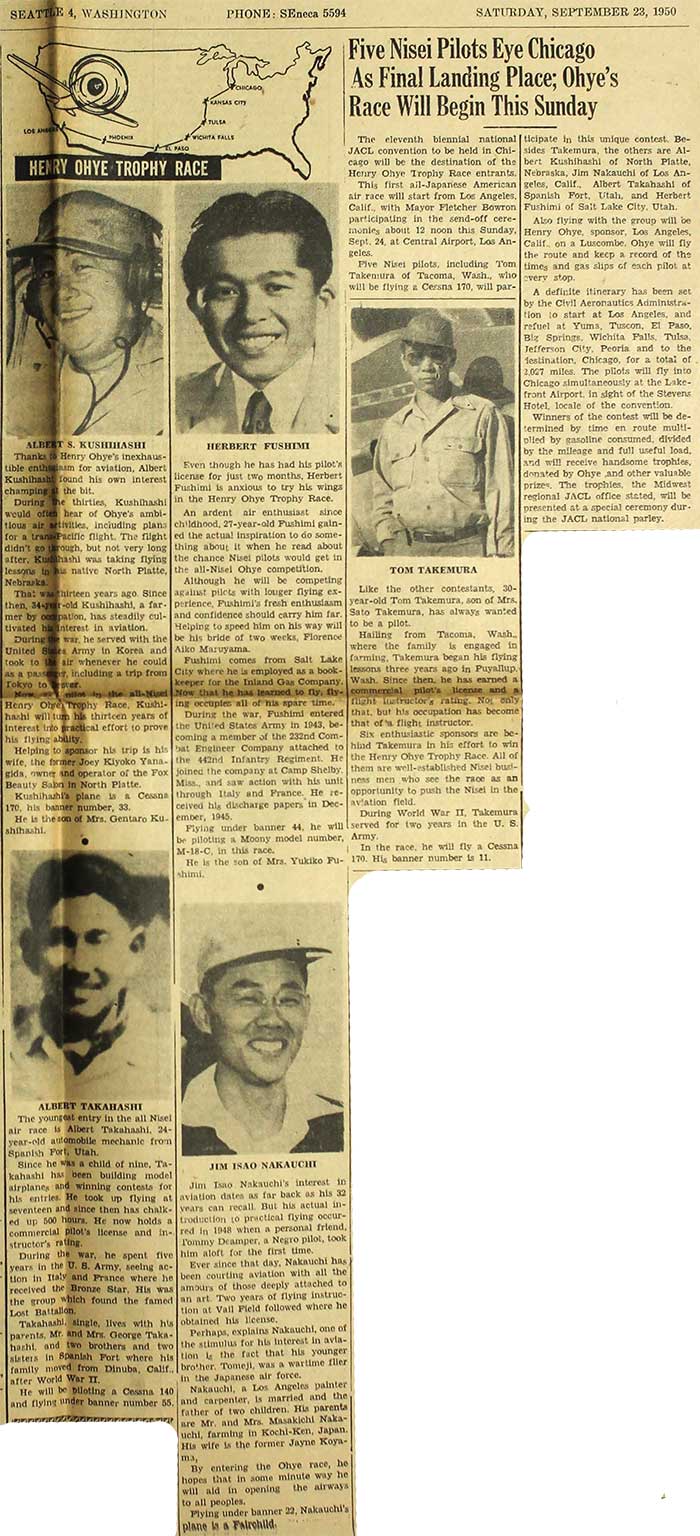 |
In 1952, Ohye sponsored another race within California that was advertised by a two-color label that announced the dates and itinerary. This label, below, and many others, are exhibited at the link.
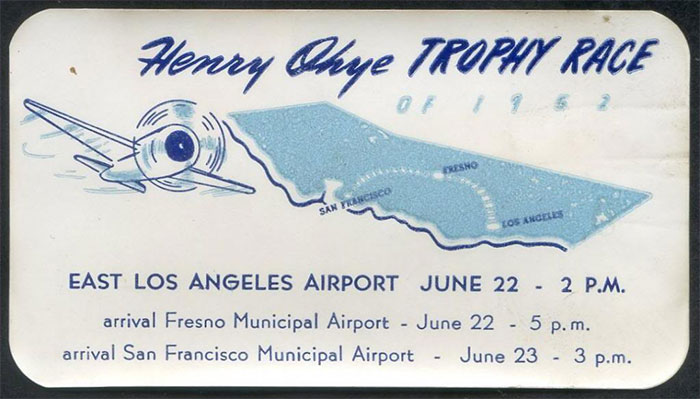 |
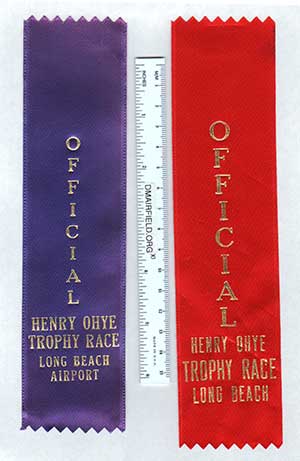 |
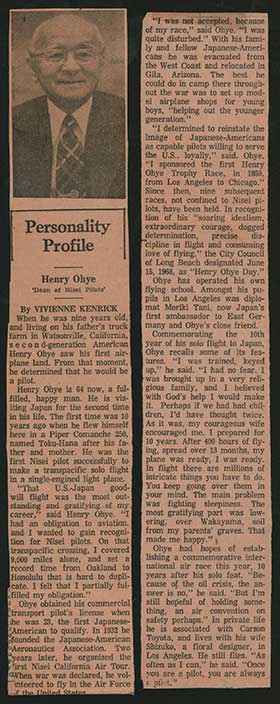 |
|---|
This 1952 trophy race was one of many that followed. They were biannual races that were encapsulated in an autographed brochure produced by Ohye to commemorate his 1972 event. The brochure is at the link, courtesy of the Ohye family (PDF 20 pp.; 5.8mB). In it you'll find a brief history of his trophy events, 1950-1972. The booklet is autographed inside the cover by Ohye to George MCord on February, 27, 1975, two years after the trophy race. The trophy queens and winning competitors through the years appear in photographs and brief biographies. The races described in the two news articles and the label, above, are also mentioned, along with their winners and queens. The five Nisei in the 1933 photograph, above are also pictured. Another photo of Harvey Kitaoka is on page 8 of the brochure. The ribbons worn by officials at Long Beach, CA, right, were probably made for the 1965 race, which ran from Long Beach to Las Vegas, NV. A five-page biography of Henry Ohye was published during the 1968-70 Trophy Race (PDF 5 pp.; 333kB)
Interestingly, Pilot Ohye's nephew George was able to locate the trans-Pacific Comanche in pristine, restored condition in Redlands, CA in 2009. Lloyd Janzen purchased N7956P in San Diego in 1987 (the same year Henry Ohye passed away). It was in very poor condition and in need of a complete restoration. Janzen and his son, a corporate pilot, restored the plane. Below is a modern photograph of Henry Ohye's Toku-Hana, as restored. The Comanche still flies “goodwill” missions (2012 article, PDF 143kB) today, as Lloyd Janzen donated N7956P to Adventist World Aviation of Milwaukee, WI on January 12, 2012.
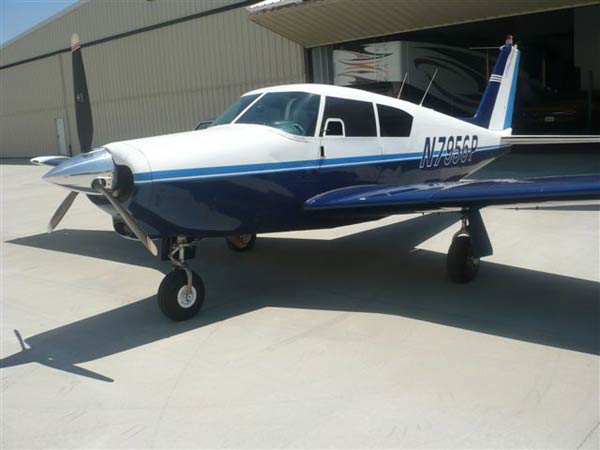 |
|---|
It is rare to find a pilot from any Register whose aircraft is/are still flying. With Henry Ohye scoring two in this regard, and his nephew living just up the block from your Webmaster, he was clearly destined to fly again on the Clover Field Register Web site. Ohye's obituary appeared in the Los Angeles Times, below. Notice his statement in the last paragraph.
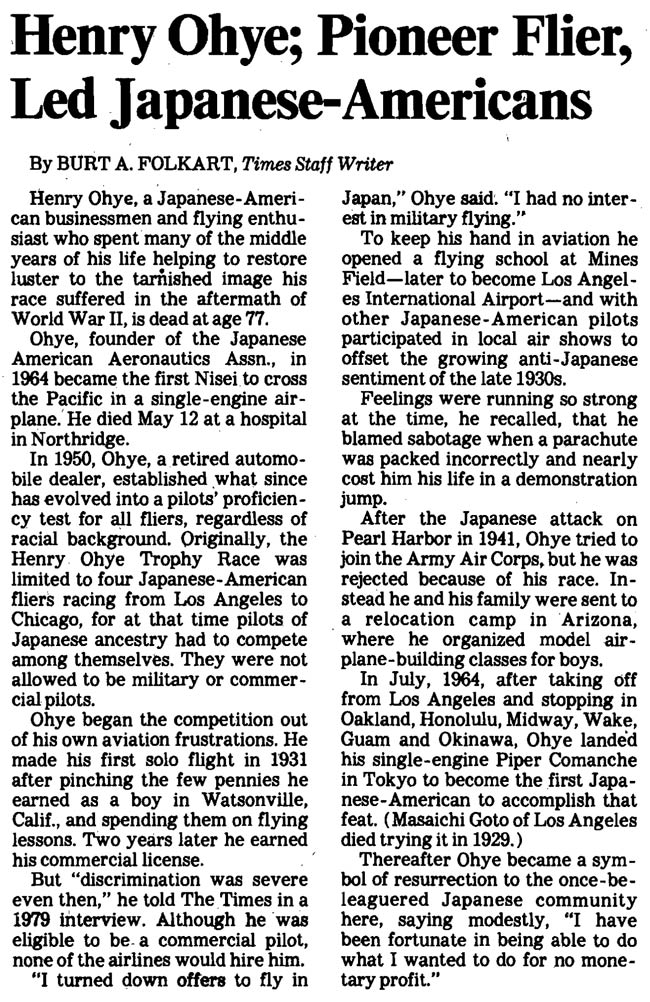 |
|---|
Further to your research, the PDF(127kB) file at the link contains 115 newspaper citations, dated 1932-1977, that reference Henry Ohye. Finally, we can all hope, too, that his quote found in the 1964 AOPA article linked above will someday come true: "I think that discrimination is now a thing of the past."
---o0o---
THIS PAGE UPLOADED: 06/13/13 REVISED: 11/30/16, 12/04/16, 03/09/17, 04/10/17, 04/15/17
